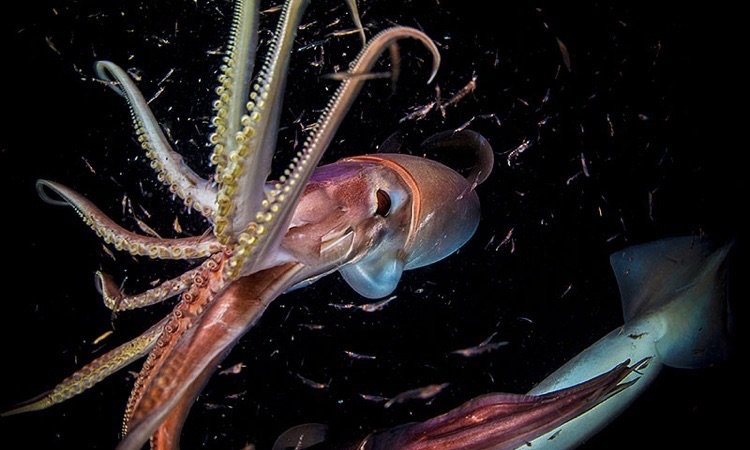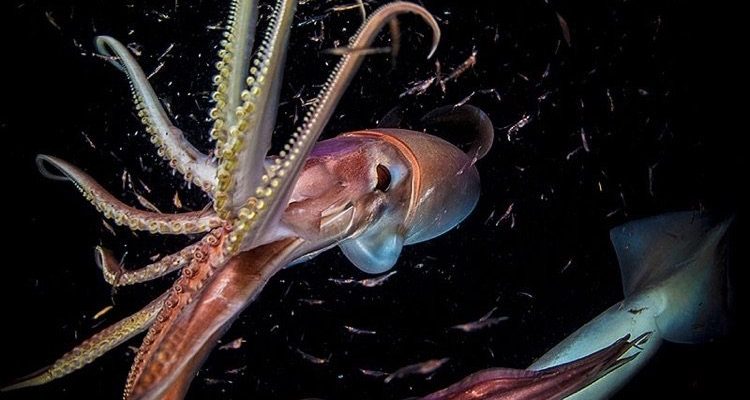
The Humboldt squid, scientifically known as *Dosidicus gigas*, live in the warm waters off the coasts of South America. But what makes them truly intriguing goes way beyond their appearance. So, grab your coffee, and let’s dive into some of the most captivating facts about these remarkable animals.
1. Size Matters: The Jumbo of the Seas
You might be surprised to learn just how big the Humboldt squid can get. These creatures can grow up to a whopping 6 feet (about 1.8 meters) long and weigh as much as 100 pounds (45 kilograms)! That’s roughly the size of a small child. Imagine swimming in the ocean and encountering something that large. It’s enough to give anyone a bit of a scare, but also leaves you utterly amazed.
Here’s the thing: their size isn’t just for show. Being this big helps them survive in a harsh environment full of predators. They are at the top of their food chain, hunting for fish and smaller squid. Their size also plays a role in their impressive speed—Humboldt squids can swim up to 25 mph (40 kph), making them one of the fastest squids in the ocean!
2. Masters of Communication
Have you ever noticed how animals communicate in fascinating ways? The Humboldt squid takes this to another level. They are known for their stunning ability to change color thanks to special cells in their skin called chromatophores. This can result in vibrant displays of red, blue, and white. When they’re excited or feeling threatened, they can shift colors rapidly, almost like they’re putting on a show!
This colorful transformation isn’t just for aesthetics. It also plays a vital role in their social interactions. When they’re hunting in groups, these color changes help the squids coordinate their movements. Picture a synchronized swimming team, but underwater and without the need for music!
3. Hunting in Packs: The Squid Army
Unlike many solitary sea creatures, Humboldt squids are social animals. They often hunt in groups, which is another fascinating aspect of their behavior. This hunting strategy, sometimes referred to as “squadrons,” allows them to take down larger prey.
When they group together, they can confuse their target with their speed and color changes. It’s almost like they play a game of tag while hunting! By collaborating, they increase their chances of a successful meal. For the Humboldt squid, teamwork really does make the dream work.
4. Intelligent Creatures
You might think of squids as mere swimming blobs of flesh, but don’t let their looks fool you. Humboldt squids are quite intelligent. They exhibit problem-solving skills and can even learn from each other. Research suggests that they have a strong memory, which helps them navigate their environment and avoid predators.
Their intelligence has intrigued scientists for years. Some researchers have even compared them to octopuses in terms of cognitive abilities. It’s not every day you encounter an animal that can think critically and adapt to its surroundings.
5. The World’s Fastest Squid
Speed is another fascinating trait of the Humboldt squid. As I mentioned earlier, they can reach up to 25 mph. This incredible velocity is essential for both hunting and escaping from predators. Think of them as the race cars of the ocean—fast, sleek, and designed for action.
This speed isn’t just about fleeing danger. When hunting, their acceleration allows them to surprise and capture their prey quickly. It’s like watching a well-practiced athlete perform at their best, each movement precise and calculated.
6. Unique Reproduction Rituals
Reproducing is a critical part of the life cycle for the Humboldt squid. Mating usually occurs in deep waters, and the process is quite dramatic. Female squids lay thousands of eggs, sometimes over 20,000 at once! They attach their eggs to rocks or other surfaces to protect them.
Here’s the catch: after laying their eggs, the female often dies shortly after. When the new squids hatch, they’re on their own right from the start. This might sound harsh, but it’s a vital part of their life cycle, ensuring that a significant number of offspring survive to adulthood.
7. Adaptability to Different Environments
One of the most impressive things about the Humboldt squid is its adaptability. They can thrive in different ocean conditions, from warm tropical waters to cooler regions. This adaptability helps them expand their range and find food in various locations. It’s like having a built-in GPS that allows them to find the best hunting spots.
In recent years, Humboldt squids have been spotted in areas where they weren’t typically found. Some scientists believe this change is due to climate shifts and changes in ocean temperatures. Their adaptability plays a crucial role in their survival as they navigate a constantly changing environment.
8. Predators and Threats
While Humboldt squids are fierce hunters, they are not without enemies. Larger fish, sharks, and even some species of whales consider them a tasty meal. In turn, the Humboldt squid has developed defensive tactics to protect itself.
When threatened, they can release a cloud of ink to obscure the vision of potential predators, allowing them to escape. This “smoke screen” approach is a classic defense mechanism among cephalopods, but the Humboldt squid takes it to the next level with its speed and agility.
9. Cultural Significance
Beyond their biological fascinating facts, Humboldt squids hold a place in various cultures. In some coastal communities, they are a staple of the local diet. Fishermen often target these squids for their culinary appeal due to their firm texture and rich taste.
They’ve also made appearances in folklore and mythology, often symbolizing power and the mystery of the ocean. Imagine attending a cultural festival where dishes made from Humboldt squid are celebrated—what a delicious way to honor these creatures!
10. Current Research and Conservation Efforts
Finally, Humboldt squids are a hot topic in scientific research. Their behavior, intelligence, and adaptability provide crucial insights into marine biology and ecology. Researchers are studying their impact on marine ecosystems and how climate change affects their populations.
Conservation efforts are underway to ensure these magnificent creatures continue to thrive. Sustainable fishing practices and habitat protection are critical to maintaining their populations. It’s a reminder of how essential it is to care for our oceans and their inhabitants.
In conclusion, the Humboldt squid is an extraordinary being that continues to intrigue scientists and ocean lovers alike. From their impressive size and speed to their social hunting behaviors and adaptability, these squids are truly the wonders of the deep. So, the next time you’re near the ocean, take a moment to appreciate the amazing life under the waves, especially the fascinating Humboldt squid!

